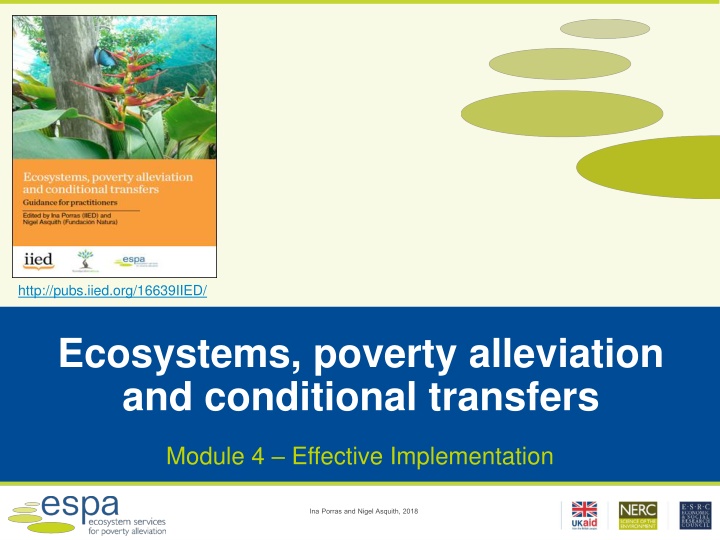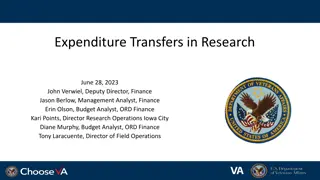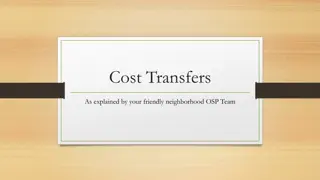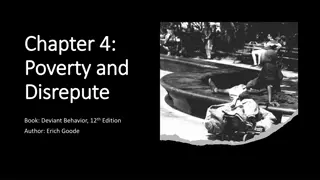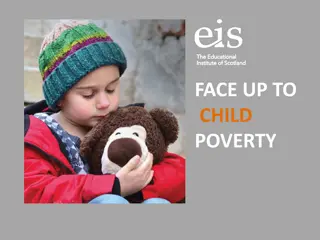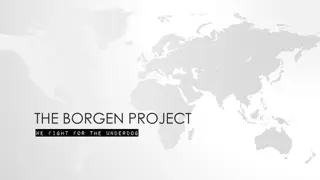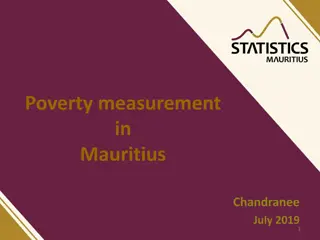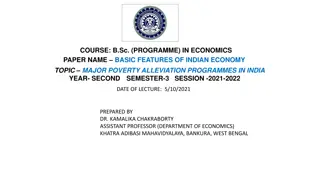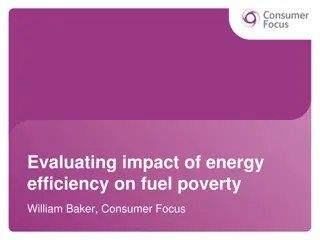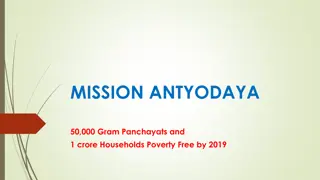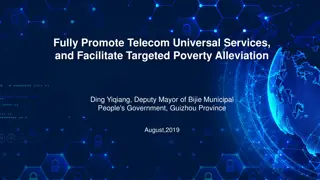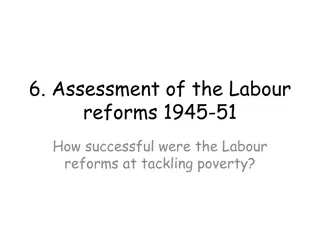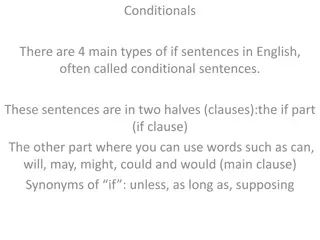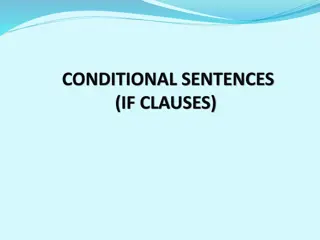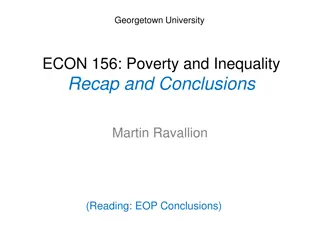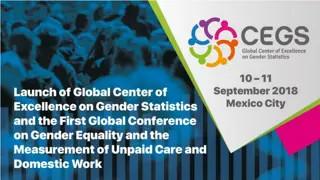Ecosystems, Poverty Alleviation and Conditional Transfers: Effective Implementation
Ecosystems play a crucial role in poverty alleviation through conditional transfers. This module explores strategies for effective implementation, including reducing costs, addressing impacts on the environment and people, and designing incentives such as direct cash payments and community projects. By focusing on design, conditionality, and incentivization, programs can achieve long-term sustainability and positive impacts on both ecosystems and communities.
Download Presentation

Please find below an Image/Link to download the presentation.
The content on the website is provided AS IS for your information and personal use only. It may not be sold, licensed, or shared on other websites without obtaining consent from the author.If you encounter any issues during the download, it is possible that the publisher has removed the file from their server.
You are allowed to download the files provided on this website for personal or commercial use, subject to the condition that they are used lawfully. All files are the property of their respective owners.
The content on the website is provided AS IS for your information and personal use only. It may not be sold, licensed, or shared on other websites without obtaining consent from the author.
E N D
Presentation Transcript
http://pubs.iied.org/16639IIED/ Ecosystems, poverty alleviation and conditional transfers Module 4 Effective Implementation
Modules 1 2 3 4 Context Experiences Financing Implementation
Impacts: on environment and on people Environmental impacts Conditionality Additionality Spill-overs Design It s a lot to do with design, and a clear theory of change Welfare impacts Payment types, procedural fairness Pre-existing inequalities Distribution
Reducing implementation costs Strategies Issue Information asymmetries Differentiated payments rather than uniform payments Time-bound payments to adopt new practices show signs of permanence after payments finish Understand the potential for adverse participant selection (which would decrease additionality); payments/reward in line with compliance and/or opportunity costs; understand other limitations (eg access to technical support, credit, cultural attitudes); target payments using combination of proxies for threat, benefit, opportunity costs. Combinations of satellite monitoring with field visits; IT systems can help substantially reduce transaction costs for monitoring; promote crowding-in by showing that PES can be supportive, ie securing land rights, etc. Design conditions based on realistic expectations of outcomes or actions. Focus on actions: easier to design and monitor. Outcome-based: focus on ecosystem services that are often more difficult and expensive to design and implement, but have a higher potential for impacts on the ecosystem services. Permanence Reducing adverse selection Increasing compliance Conditionality
Incentives Costa Rica and Mexico national PES make direct cash payments South Africa makes cash payments in the form of a minimum wage equivalent Community carbon projects in Uganda and Mexico transfer part of revenues as individual payments, and a part is kept in a group fund Often used for community projects, where individual payments would be diluted if subdivided. Mikoko Pamoja carbon project in Kenya spends 32 per cent of its revenues to support community projects (chosen by the community); eg water and sanitation projects, improving local education, and restoring mangroves. Watershared in-kind compensations bee hives, barbed wire, and fruit tree seedlings are tokens of appreciation or a behaviour change nudge , rather than economic transactions, and comprise lower amounts than opportunity cost. Cash (as PES and wages) In-kind Bolsa Floresta uses a mix of incentives that include: Bolsa Floresta Renda: community investments of US$70k/year/reserve to support income-generating activities Bolsa Floresta Social: US$30k/year/reserve for improvements in education and community infrastructure. Bolsa Floresta Associa o: about US$10k/year supporting associations of reserve dwellers. Bolsa Floresta Familiar: approx. US$90k/year/reserve distributed as monthly cash transfers of an average value of US$170 to the female spouse of the household. Mix
Impact Pathways Does the programme result in better ecosystems and livelihoods? Is there a change in behaviour leading to better management strategies? Expected impacts: Better ecosystems/ reduced poverty Impact pathway Examples of strategies to measure impact Design (ex-ante) Strategies to make change in behaviour acceptable : Pragmatic activities Targeting (ecosystems and people) Participatory, local engagement Meaningful level of transfer or incentive Monitoring (during) Strategies that help monitor this change in behaviour: Streamlined approach, with clear, simple indicators for compliance Capacity to monitor Clear rules for defaulting Quick feedback mechanisms Evaluation (during/after) Strategies to evaluate impact on land use and/or ecosystem services: Baselines, randomised control group, participatory evaluations, Feedback mechanisms
Impact evaluation: non-linearity of scale and time Outcome: impact on ecosystem services (e.g. water quality) max Thresholds: Good ideas applied only at small scale may not show results. b Evaluating impact: Evaluations conducted too early may show low impact and discourage efforts. a Strategy? is it possible to boost early stages of project for example through direct interventions, and follow up with behaviour incentives? c 0 max 0 Action: scale of implemented action (e.g. hectares enrolled in PES)
Conclusions Challenges Most of the schemes suffer from targeting errors which can broadly be defined as inclusion and exclusion errors; and subsequently elite capture Opportunities Encouraging evidence on positive social and ecological impacts in all cases Use of information, communication and technologies (ICTs) to reduce cost of monitoring and evaluation Private sector engagement to ensure financial sustainability Observed behavioural change and enhanced resilience A divergence between preferred and actual compensation packages undermines effectiveness Rampant freeriding and limited capacities for effective policing and compliance. Lack of clear exit strategy or ability to graduate from the programmes.
PES vs. conditional transfers Conditional Transfers tend to: PES tend to: Conditional Transfers tend to: PES tend to: Have a clear social objective and are able to focus on the poor and ultra-poor Support direct, one-off interventions with short-term impacts, which may not change long-term behaviour Provide tangible benefits to the ultra-poor, including people without land Undertake environmental projects at large scale, but struggle to do so efficiently Have rural development as a secondary objective, but often as an afterthought Provide continuous low-level support that can change social norms and behaviour over the long term Support landowners and land managers, and so cannot effectively alleviate extreme poverty Have environmental objectives as their primary goal
This work represents the reflections of a wide range of practitioners, researchers and policy makers involved in the daily implementation of conditional transfers and payments for ecosystem services programmes. We would like to thank the ESPA programme for providing the funding to conduct this review, as well as the space to access the very latest scientific advances on ecosystems and poverty alleviation in developing countries. We would like to especially thank Paul Steele, Bhaskar Vira, Esteve Corbera, Virgilio Viana, Mahesh Poudyal, Kate Schreckenberg and Julia Jones for their insightful comments and feedback along various stages of this work. We would also like to specially thank Zaiza Khan and Cinzia Cimmino for their support in editing this document. All errors and omission remain the responsibility of the authors. Ina Porras and Nigel Asquith, 2018 For more information and materials visit: http://www.iied.org/
Notes by slide There is no easy, one-size fits all solution to implementing CT/PES. Instruments must respond to context, and to the pre-existing institutions, rules and conditions that affect people s behavior. In some situations, it will be impossible to ignore the poverty alleviation agenda: for example, poor people live in targeted ecosystems and could be affected or displaced. This is neither simple nor cheap, and should be actively approached with clear objectives, instruments and ways to monitor and adjust. In this Section we look at emerging systems and tools to improve the way programmes are implemented, and specially how they can be brought to achieve meaningful scales. Much of the lessons have been provided directly by practitioners engaged in the case studies presented in Module 2, through focus groups, policy workshops and literature review. 4 Effectivenessis the change in the provision of services induced by the programme, compared to a counterfactual without CT/PES (B rner et al., 2017). Effectiveness in the field is determined by four main factors: Programme costs transaction and implementation costs net of PES transfers which determine the number of contracts that can be offered for a given programme budget and payment level. Direct changes in land/resource use among participants inducted onto the programme, compared to a baseline of `no PES (additionality). Indirect effects (positive or negative) of the programme on land/resource use and environmental service (ES) provision outside of contracted land (spillovers). Effects that these changes in land/resource use among participants and non-participants have on the actual provision of environmental services. For example the biophysical link between induced behavioural changes in practices and the targeted ES). Scale is ultimately linked to this, for example looking at the number of project participants within the overall scale of the ecosystem. Each of these factors is, in turn, shaped by the interplay of features related to the context, design, and implementation of the programme (Figure 8, also see Engel et al., 2015; Persson and Alpizar, 2013). The cost-effectiveness of a small-scale conservation intervention, such as Watershared, increases if there are only a few, motivated stakeholders, and such actors can play a critical role in monitoring. Most importantly, the geographical proximity of service users and providers can promote strong conditionality . If a landowner removes her trees it will quickly be obvious to their downstream counterparts. Downstream authorities have a clear (and often fiduciary) responsibility to check whether the compensation mechanisms (i.e. the development projects) have been implemented, and if watershed conservation has occurred (Asquith, 2016) and so have a specific direct interest in all parts of the programme s theory of change Successful programmes are often concerned with reducing implementation (or `transaction ) costs. These costs can be linked to technical or governance issues: Technical: identifying ecosystem services, targeting eligible land uses/providers, and design of payment type (uniform, differentiated, continuous, one-off, cash, in-kind), which require understanding opportunity costs and asymmetries of information (leading to information rents), designing monitoring strategies and feedback channels, and adjusting strategies. Needs technical and GIS experts. Implementation costs: Up-front costs to create mechanisms (setting up institutions, background studies, etc); payments/compensations/rewards to participants; transaction costs for project managers (promotion, administration, supervision, technical support, contracting) and for participants (investments, time, paperwork, technologies); monitoring and evaluation (M&E). 5 Governance: property rights regimes, negotiation, solving disputes, legal issues. Meaningful incentives to change behaviour both cash and in-kind, are at the core of PES and CT programmes. The types of incentives vary greatly, from cash payments by direct transfer to individuals to cover their opportunity cost of land conversion (Costa Rica), to delivery of community sanitation projects in Mikoko Pamoja, Kenya. Incentives can be allocated individually or at community level, reflecting the fact that delivering ecosystem services requires group action, and that wellbeing goes beyond individual household income. A common theme is that, to be effective in promoting changes in behaviour, incentives need to be meaningful . However, what constitutes meaningful varies, and will change over time. For example, incentives provided by the Philippines Greening the Nation Programme appear sufficient for tree planting, but may be insufficient to ensure tree survival after ten years (Lachica, 2014). The programme is studying the potential to to use parallel incentives, such as - driven programme andme and roughotu searchers, 1 visit with one researcher engagement, ysical modeller. staff time (estimate harvesting rights, interim livelihood support (e.g., marketing and product development support, capacity building and organisation development support), and mechanisms for long-term financing, such as PES schemes, as well as addressing tenure issues in community forests. 6
Robust information that clearly demonstrates impact, in terms of healthier ecosystems and less poverty, was a major gap in almost all the programmes we analysed. Few programmes had clear social or environmental baselines. There are few examples of rigorous project evaluations (eg Mexico and Costa Rica), but they tend to be site specific rather than at country level. Because of their long-term implementation, the community carbon programmes in Mexico and Uganda have also been the subject of multiple studies (eg Wells et al. (2017). The Bolivian Watershared programme has been evaluated through an ESPA-funded randomised control trial (Grillos, 2017; Jack and Recalde, 2015). 7 Demonstrating impact can also be difficult when projects remain small due to potential non-linearity in the relationship between actions and outcomes. Pynegar (2018) recently conducted an impact evaluation study of the Watershared programme in Bolivia, as part of his PhD with Bangor University. In his thesis he discusses how non-linearity can affect not only outcomes but the messages emerging from impact evaluation (Figure 10). Type a projects show a linear kind of action-outcome relationship. Type b projects are those where relatively small-scale implementation can quickly impact ecosystem services (or other outcomes of interest), but which then peak and remain at that level irrespective of additional enrolment. This could be for example projects that are very finely-tuned and targeted. Type c projects show slower impact on ecosystem services initially, for example because properties are small and scattered, or not in target areas, but their impact would increase once it reaches the scales (and time) needed, for example through reaching all stakeholders within target areas. Impact evaluation will show very different results for the three projects. Conducting impact evaluation during the early stages of a Type C project will not only be expensive but could potentially show negative or insignificant results, which could be harmful if misinterpreted. It is important to be aware of the different kinds of action-outcome relationship when designing projects and evaluating impacts. Academic institutions are important partners in advancing tools for the design of CT/PES programmes and in identifying indicators and methodologies for tracking impacts. 8 There is significant potential for cross learning from social and environment CTs. Moreover, this can be a valid argument to promote greater integration across traditionally separate government departments (social and environment). New tools developed by academic research can help policy makers improve the efficiency and effectiveness of these programmes, as well as provide strategies to deal with the inevitable trade-offs that will emerge. International support has often been catalytic in the emergence of local projects, supporting studies that provide the evidence of pathways of impact, and supporting dialogue inside countries, South-South collaborative learning, and technological transfer for improved programme design, monitoring and evaluation. There is high potential for mutual benefit from CT/PES programmes and the academic sector, with universities and research organisations providing support for technological transfer and impact evaluation, while project provide the learning hubs for practical teaching. Several points emerge from the case studies and the potential of linking environmental and social objectives, and how to bring these to larger scales. 9 CTs and PES have the same starting point: the assumption that direct, conditional incentives are the most effective way to change behaviour. However, although many PES schemes have rural development as an objective, they have struggled to implement mechanisms to engage the poor and alleviate poverty. In contrast, CTs have made great strides in promoting social protection and income stability, but their environmental impact has been limited. Table 10 highlights the differences between CTs and PES, but also suggests that there is significant scope for developing hybrid programmes that take advantage of model complementarities. Indeed, such hybrids are already being tested in the Bolsa Floresta, Watershared and Jatka conservation programmes. 10
